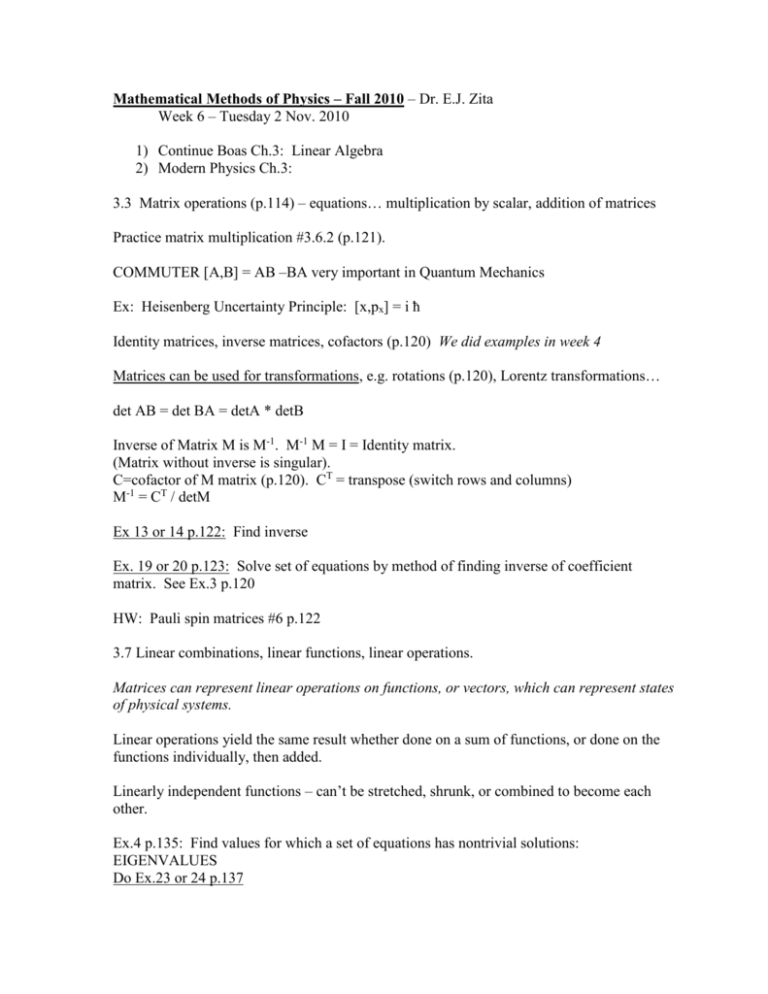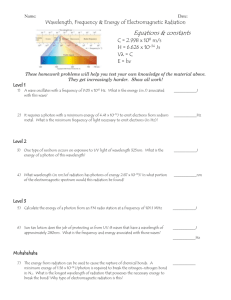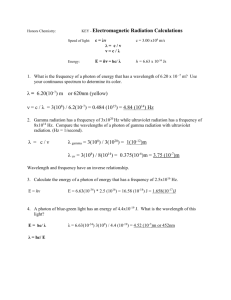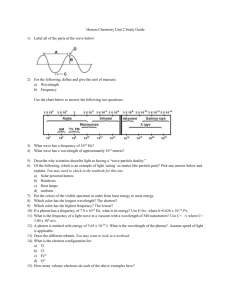Fall6Boas3Mod3 - Academic Program Pages at Evergreen
advertisement

Mathematical Methods of Physics – Fall 2010 – Dr. E.J. Zita Week 6 – Tuesday 2 Nov. 2010 1) Continue Boas Ch.3: Linear Algebra 2) Modern Physics Ch.3: 3.3 Matrix operations (p.114) – equations… multiplication by scalar, addition of matrices Practice matrix multiplication #3.6.2 (p.121). COMMUTER [A,B] = AB –BA very important in Quantum Mechanics Ex: Heisenberg Uncertainty Principle: [x,px] = i ħ Identity matrices, inverse matrices, cofactors (p.120) We did examples in week 4 Matrices can be used for transformations, e.g. rotations (p.120), Lorentz transformations… det AB = det BA = detA * detB Inverse of Matrix M is M-1. M-1 M = I = Identity matrix. (Matrix without inverse is singular). C=cofactor of M matrix (p.120). CT = transpose (switch rows and columns) M-1 = CT / detM Ex 13 or 14 p.122: Find inverse Ex. 19 or 20 p.123: Solve set of equations by method of finding inverse of coefficient matrix. See Ex.3 p.120 HW: Pauli spin matrices #6 p.122 3.7 Linear combinations, linear functions, linear operations. Matrices can represent linear operations on functions, or vectors, which can represent states of physical systems. Linear operations yield the same result whether done on a sum of functions, or done on the functions individually, then added. Linearly independent functions – can’t be stretched, shrunk, or combined to become each other. Ex.4 p.135: Find values for which a set of equations has nontrivial solutions: EIGENVALUES Do Ex.23 or 24 p.137 PIQS P2. A homogeneous system of N equations with N unknowns is solvable if the determinant of the coefficients is zero. P3. Matrix M can be diagonalized by a similarity transformation only if M is symmetric. (IPL) I1. The trace of a matrix set can be permuted cyclically. I2. Vector spaces only utilize two operations, addition and multiplication. (IPL) QUESTIONS What is an eigenvector? A natural state of the system, e.g. a natural mode of oscillation. (AU) What is an eigenvalue? A simple solution of the system, e.g. the natural frequency of oscillation. What is the significance of diagonalizing a matrix? The diagonal values are eigenvalues. Diagonalization provides a better choice of variables and thus amounts to a simplification of the problem. (Boas 150) (UH2O) * It is hard for me to see the difference between a linear operator and just some term that "shrinks" or "grows" a given matrices? (Boas 124ish) (UH2O) Linear operators can also combine functions. * The book gives a very brief introduction to groups and mentions that there are physics applications. Can you give an example of one such application? (Boas 172) (UH2O) Unified field theories in particle physics Q1: What are the applications for using matrices in a complex euclidean space (Boas, 146)? Oscillations! Q3: What are the most common application in which to use matrices? (Team Physics) Rotations, oscillations, neutrino mixing, any solution of multiple equations in multiple unknowns Q2. Is there any practical use for the trivial solution? no Q3. What is the use of the secular determinant. (IPL) ?? Modern Physics Ch.3: Light as particles (64) Review of wave equation: y = y0 sin (kx-t). Wave speed v = frequency*wavelength = /k. Find d2y/dt2 and d2y/dx2. Relate the two derivatives with the speed. 3.1 Review of electromagnetic waves: Derive EM wave equations from Maxwell equations – WORKSHEET. Half the class derive E waves, half derive B waves. (later) See Fig.3.1 for directions of EM wave: polarization and direction of energy transport. E02 1 Power E×B , S S Poynting flux = Power/area S . Intensity 0 Area 2 0 c Sub in E0=cB0 to find S in terms of the magnetic field amplitude B0. Double-slit interference – get striped rope – derive maxima at yn=nD/d and dsin=n Bragg Scattering: maxima at 2dsin=n Ex 2 (p.95): In Ex.3.1, what angle of incidence will produce the second-order Bragg peak? s 3.2 Photoelectric effect: (71) Predict what you’d expect if we: turn up the intensity of the light on the metal, keeping the color the same make the light bluer and turn the intensity way down keep the intensity high and gradually tune the light frequency down More electrons? Fewer? More energetic electrons? Less energetic? No change? Wave theory says the electron energy ~ intensity of the light. Light particle carries E = h = hc/ and momentum p = E/c = h/. (mass = 0) Observed: energy of incoming light = work function of metal + K of ejected electron h Kmax (Recall h = 6.6 x 10-34 J.s = 4.1 x 10-15 eV.s = 1240 eV.nm) Ex.4 p.95: Find the momentum of (a) a 10 MeV gamma ray (and other particles, if you finish early) Ex. 6 p.96: What is the wavelength of gamma ray of 10 MeV? (and other particle, if you finish early) If a photon has just barely enough energy to liberate an electron from a metal with some work function f, FIND the cutoff frequency c of the photon __________ How could you use this relationship to measure Planck’s constant experimentally? (p.75) Ex.8: What is the cutoff wavelength for the photoelectric effect using an aluminum surface? Ex.10: A metal surface has a photoelectric cutoff wavelength of 325.6 nm. It is illuminated with light of wavelength 259.8 nm. What is the stopping potential? Ex.12 for a challenge if you finish early 3.3 Blackbody radiation: (77) Stefan’s Law: Intensity = T4 where = 5.67 x 10-8 W/m2K4 = Stefan-Boltzmann const. Wien’s Law: maxT = 3 x 10-3 m.K Q1 (IPL) What is the closest real life example of a black body? STARS EX: Sketch BB curves for Earth and Sun. EX: How much more radiation does a star emit if its surface is twice as hot? Blackbody: reflects no radiation consider a hot box emitting radiation from a hole – that is the BB radiation box is filled with EM radiation all possible wavelengths contribute to the radiation radiation is in thermal equilibrium with walls of the box all incoming radiation is absorbed dI 8 c 4 kT leads to ultraviolet catastrophe. d 4 8 c hc 1 Planck invented quantum h to solve blackbody problem: R ( ) 4 hc 4 e kT 1 2 5 k 4 -34 Where h = 6.6 x 10 J.s (angular momentum units) and 15c 2 h3 (We’ll derive Planck’s law in Chapter 10) Rayleigh-Jeans formula for radiancy = R ( ) Ex.16: By differentiating Planck’s equation, Show that R has its maximum as expected according to Wien’s displacement law, Eqn 3.29. Ex.20: COBE radiation has T=2.7K. Find peak wavelength, and energy in eV. In what region of the EM spectrum is this wavelength? Ex.22 – do if you finish early 3.4 Compton Effect: Conservation of momentum between photon-particle and free electron (nearly free) (83) Use Einitial = Efinal and Pinitial = Pfinal to find Compton Wavelengths: = wavelength of incident photon ’ = + h/mec (1-cos) where = photon scattering angle Change of wavelength of electron = h/mec 3.5 Bremsstrahlung and other x-ray production due to electron deceleration / acceleration (87) I3: Both the brehmsstrahlung process and pair production require the presence of atom nearby in order to supply the necessary recoil momentum (Krane, 89). (Team Physics) Electrons with K=eV strike target and are slowed down to K’, giving photon energy h: Energy in = Energy out: K = K’ + h. Smallest photon wavelength for maximum electron energy loss: h = hc/ = K = eV where V is the accelerating potential for the electron. Ex p.88: Typical V~ 10,000 volts yields continuous X-ray distributions – Fig 3.24 p.89 Bremsstrahlung. Pair production (89) Photon disappears and produces particle + antiparticle. Assume pairs are produced essentially at rest. Ex: e + positron each have rest mass .511 Mev, so photon must have 1.022 MeV What is a photon? (p.90) speed = c mass = 0 photons have energy E = h = hc/ and momentum p = h/ can be created or destroyed when radiation (e.g. particles) are emitted or absorbed can have particle-like collisions with other particles such as electrons Light also exhibits wave-like properties such as interference and diffraction. QM: Which is it, wave or particle? If we send a light wave through a double-slit experiment, then detect which slit it went through (e.g. with a photocell), we destroy the wave nature of the light and reduce it to particle-like behavior. Light behaves like a wave even if you send only one photon at a time through a device, as long as you don’t observe the photon along the way. Observation “collapses the wave function” and changes the experiment. The experimenter is part of the experiment. Q2: Can it be predicted whether a photon will act more wave-like or particle-like in any given experiment? (Team Physics) It depends what we choose to measure! Modern PIQS: The delayed choice experiment detailed on page 91 of Krane shows that it is not the case that light is sometimes a particle and sometimes a wave. The experiment shows that light has properties of a particle and of a wave all the time. On page 93, Krane writes that particle and wave behavior “must somehow be taken together to give a complete description of the properties of electromagnetic radiation.” (AU) Recently experimenters were able to perform the double slit experiment using buckyballs (molecules made out of sixty carbon atoms). (see http://sci.techarchive.net/Archive/sci.physics/2009-04/msg00842.html) (AU) Modern QUESTIONS Under what circumstances is it convenient to regard a photon as having a mass? (page 74, Krane) I DON’T RECOMMEND IT








